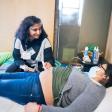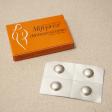Donated eggs are used in roughly 12% of assisted reproductive technology cycles performed in the US, yet we have little information on the immediate health outcomes for egg donors. With growing demand for donor eggs, it’s crucial to learn more about donor experiences and outcomes.
The most common immediate complication for donors is ovarian hyperstimulation syndrome (OHSS), which can be mild, moderate, severe, or in rare cases can become critical. Symptoms range from mild bloating to rapid weight gain, extreme abdominal bloating requiring a procedure to remove fluid, nausea and vomiting, and passing out. Critical OHSS can result in respiratory distress and kidney failure.
Identifying risk factors for OHSS and ways to decrease risk is especially important for donors, who are undergoing a procedure for no medical benefit to themselves. It’s vital to gain a better understanding of occurrence of OHSS among donors and potential risk factors. Research led by Diane Tober looks at donors’ reports of experiences to explore possible linkages between stimulation protocols, donor production, and frequency and severity of OHSS.
The survey of 289 donors found:
Moderate OHSS symptoms were most common, with 39% of donors reporting. Twelve percent reported severe, and just over 1% reported critical cases.
Looking at symptoms for each individual donation cycle, most resulted in mild symptoms or none. Twenty-six percent of the cycles resulted in moderate symptoms.
Severe OHSS was most common in cases where the donor received an hCG shot as a trigger before egg retrieval.
Donors reported severe OHSS in 5-7% of cycles with retrieval of 10-49 eggs, and 26% of cycles when 50 or more eggs were retrieved. There were no severe cases when fewer than 10 eggs were retrieved.
Risk for severe OHSS increased according to number of eggs retrieved when any type of trigger is used, but is still lower for those who receive a GnRH agonist trigger (a different type of shot to prepare eggs for retrieval).
The level of symptoms in the first donation cycle predicted severity in future donation cycles—71% had the same degree of symptoms in the 2nd cycle as the first. More than a third of donors who did a second cycle after experiencing severe symptoms did again in the 2nd cycle, raising the question of whether severe OHSS might be a reason to disqualify a donor from future donation cycles.
This paper is the most comprehensive known investigation of OHSS in egg donors. The results can help inform clinics on how to improve donor care and reduce risks for complications, improving donor satisfaction and safety. OHSS is a preventable, potentially life-threatening condition that can largely be avoided if measures are taken to avoid risk. These findings show how the type of trigger shot, number of eggs retrieved per cycle, and prior experience with OHSS all contribute to a heightened risk for severe or even critical OHSS. Clinics should consider these factors when determining protocols and donor suitability.

